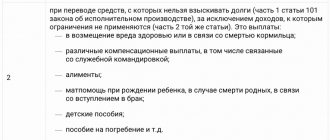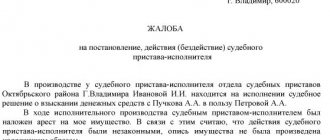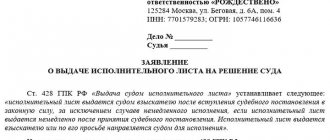Failure to pay any type of debt often results in a lawsuit. Moreover, it is necessary not only to win the trial, but also to recover the amount due from the defendant. According to statistics, the latter rarely do this on a voluntary basis. The plaintiff’s submission of a writ of execution to the Bailiff Service (FSSP) will help to finally resolve the material conflict. In rare situations, the judicial authority does this on its own.
When is an application required?
Sometimes the plaintiff does not know how to submit a writ of execution to the bailiffs. A citizen must apply to the FSSP if necessary:
- Forcibly seize the debtor's property.
- Oblige the evader to pay cash.
- Locate a person.
- Etc. according to the executive document.
Typically, the following groups of persons act as collectors in these cases:
- Banking industry employees (if the borrower does not pay the principal debt, fines or penalties on it).
- Women who are divorced and have young children in their care (if the ex-husband does not provide financial assistance in the form of alimony).
- Individuals (when it is necessary to search for a child).
- Citizens who were illegally evicted from their occupied area (in order to be forced to resettle them back).
- Workers whose contract was terminated without legal grounds.
In the latter case, the bailiff may request the applicant's autobiography and attach it to the materials available in the case.
Types of petitions in enforcement proceedings
The exact list of statements and petitions that participants in the case can submit is not specified in Law No. 229-FZ. I will highlight the most common questions on which you can contact bailiffs with petitions:
- on the performance of certain enforcement actions (for example, on the seizure of the debtor’s accounts and property, on visiting his place of residence to draw up an inventory of assets, etc.);
- on the imposition of interim measures against the debtor, i.e. introduction of a ban on traveling abroad and deprivation of the right to drive transport;
- on the time and place of execution of enforcement actions, replacement of seized property with other assets;
- on the restoration of procedural deadlines (for example, on the restoration of the period for appealing the bailiff’s decision);
- on the resumption, termination or suspension of enforcement proceedings;
- on the exclusion of certain things and objects from the inventory of seized property;
- on reducing the amount of deductions compared to the figures previously specified in the bailiff’s resolution;
- on familiarization with the case materials, provision of extracts and certificates of debt;
- on the introduction of a search regime for the debtor or his assets;
- other statements and petitions.
Naturally, when filing a petition, you need to confirm your status as a participant in enforcement proceedings, or your interest in its outcome. For example, the proper owner can file a petition to exclude property from seizure, even if he is not a party to the case.
Let's look at the basic rules for filing petitions, depending on its content.
Petition for restoration of deadlines
When submitting requests to restore missed deadlines, you must immediately indicate valid reasons. The application must be accompanied by evidence confirming the valid reasons for missing the deadline. The bailiff is obliged to evaluate the submitted documents on their merits, make a decision on restoring the deadline or refusing to satisfy the application. The refusal can be appealed to a higher official of the FSSP, or through the court.
Find out more Legal services for enforcement proceedings
Petition to bailiffs for enforcement actions
The progress of enforcement proceedings may depend on the statements and petitions of the participants in the case. For example, at the request of a claimant or debtor, the following decisions may be made:
- about declaring a search for the debtor and his assets, if such a decision was not previously made by the bailiff himself;
- on independent sale of property (the debtor can exercise this right under the control of the bailiff and the collector);
- on sending enforcement documents to the debtor’s place of work (for example, if the petition indicates a place of work that the bailiff had not previously identified).
At the request of the claimant, the proceedings may be resumed, terminated or suspended. To do this, you need to refer to a specific article of Law No. 229-FZ and confirm the grounds for the appeal.
Petition to bailiffs to reduce the amount of deductions
Law No. 229-FZ specifies the maximum amount of deductions from the debtor’s wages. If, for objective reasons, the debtor cannot normally live on the remainder of his earnings, he may file a petition to reduce the amount of deductions. Valid reasons for such a petition include partial loss of ability to work, illness, the addition of other dependents in the family, and other factors. If a request to reduce the amount of withholding is rejected, it can be appealed through the subordination order or through the court.
Procedure for drawing up an application
You can find out where to submit the writ of execution on the official Internet resource of the Bailiff Service - fssprus.ru. The filing of an application addressed to the FSSP bailiff is carried out in accordance with the established procedure.
The “header” (upper corner of the sheet on the right) contains the following information:
- Information about the addressee (full name, position).
- Information about the applicant (full name, place of residence, contact details).
The descriptive part must indicate the essence of the statement. As a sample, you can consider an application to bailiffs for the collection of alimony. Then the text should indicate:
- Information about the court decision issued.
- Information about the child (children) for whose support funds are being collected.
- Account details for transferring financial assistance.
The final stage is a list of attached documents (original court decision, account details, etc.), date and signature of the applicant.
To ensure that the application to the bailiff service is written correctly, it is better to use the established form. The document will be accepted and recorded in the appropriate journal on the same day. Sample application to bailiffs:
What is a petition to bailiffs
A petition is a formal request. In enforcement proceedings, a petition allows:
- exercise the rights granted to the debtor or claimant by Law No. 229-FZ;
- achieve certain actions and decisions on the part of the FSSP specialist;
- extend, restore or suspend procedural deadlines;
- obtain certain documents from the case materials, or request them with the assistance of bailiffs.
In most cases, the petition is submitted in writing. This will allow you to officially register the document, receive an incoming number, and control the timing of consideration of the application. When performing certain enforcement actions, oral petitions can be submitted. In this case, the bailiff will reflect the essence of the petition in the procedural document, make a decision on the merits at the place of action or in another manner consistent with Law No. 229-FZ.
Note! Article 50 of Law No. 229-FZ allows you to submit petitions and other documents in electronic format. To do this, the applicant must have an electronic signature, which verifies the signature on the documents. Electronic requests are considered according to the same rules as written documents.
What can and should be indicated in the petition to the bailiffs
In order for the application to be considered on its merits, the following rules must be observed:
- the document must contain information about the enforcement proceedings (as a rule, it is enough to indicate the case number), about the FSSP official to whom the request is addressed;
- the document must contain information about the applicant, his contact details, personal signature (anonymous applications will not be considered by the bailiff);
- When submitting an application through a representative, you must attach a notarized power of attorney.
Find out more What bailiffs cannot describe in an apartment
Standard forms of petitions are not approved by law, so you can draw up a document in any format. However, the positive consideration of the application by the bailiff depends on the accuracy of the wording and the validity of the request.
Submission order
An application to bailiffs for a writ of execution is submitted in the amount of 2 pieces. One copy will be marked with an acceptance mark indicating the date and registration number of the application.
A bailiff in the specified case is appointed within 3 days from the date of submission of documents (in accordance with Federal Law No. 229). After 3 working days, he must initiate enforcement proceedings, for which a resolution is drawn up. A copy is sent to the following persons:
- To the claimant.
- To the judiciary.
- The defaulter, thereby giving him the opportunity to pay off his debts within 5 working days.
Sometimes the bailiff does not formalize enforcement proceedings within the required period. In this case, you can report the violation to senior management (senior bailiff). Read about how to correctly write an application for a bailiff.
If the applicant cannot appear at the FSSP on his own, the application may be sent by registered mail. To avoid problems in the future, it is better to keep the return notification confirming delivery of the application. It is mandatory to send a corresponding request to the Bailiff Service when changing your place of residence.
Deadlines for applying for a writ of execution
The law does not provide for a time limit for receiving a writ of execution by the plaintiff: you can apply the next day after the decision comes into force, or a month or two later - but the date of commencement of enforcement proceedings by bailiffs depends on this.
In cases where a writ of execution is needed urgently, the application should be written as early as possible and submitted on the day the court decision comes into force. Also, to speed up the process, you can regularly call the office and ask if the document is ready.
Sample complaint about red tape when issuing a writ of execution
It should be remembered that the office has no reason to delay the issuance of the document too much (more than 30 days). If you think that the office is deliberately delaying the issuance process, you should write a complaint to the chairman of the court about the red tape when issuing the writ of execution.
Summary
Alimony money is paid as a result of a court verdict, according to a writ of execution (or order) drawn up by the court. Bailiffs are responsible for collecting the amounts assigned by the judge.
In order for them to begin their duties, they need to receive a writ of execution and a statement from the recipient. About the contents of this application, the deadlines for its submission, features of renewal, necessary documents and actions; and also about whether child support can be suspended, we discussed in this article.
Termination of proceedings by the bailiff
Termination of alimony proceedings is possible upon the occurrence of certain circumstances, which must be reported to the bailiff so that he can issue an appropriate ruling.
Such circumstances include:
- The child reaches 18 years of age.
- Registration of marriage before adulthood or emancipation. In such a case, you must additionally attach a copy of the emancipation or marriage to the application. If a person does not have these papers in his hands or does not have the opportunity to obtain them, he can apply for them.
- Death of the recipient of funds or their payer. Then you must provide paper confirming that you have measured your face.
- The occurrence of circumstances that were specified in the agreement. This happens in cases where funds are collected according to an agreement between the payer and the recipient of payments.
Necessary documents for initiating an individual entrepreneur
Speaking about the collection of children's money, we should not forget that in order to carry out enforcement proceedings, it is necessary to provide the bailiffs with one of the following documents as a basis:
- IP (a writ of execution can be obtained only after a court verdict);
- court order for collection;
- an extract from the court verdict on collection;
- a written agreement on alimony certified by a notary.
In addition to one of these documents, you must provide:
- identification;
- a document certifying the birth of the child;
- bank details for transferring child benefits or postal address.










